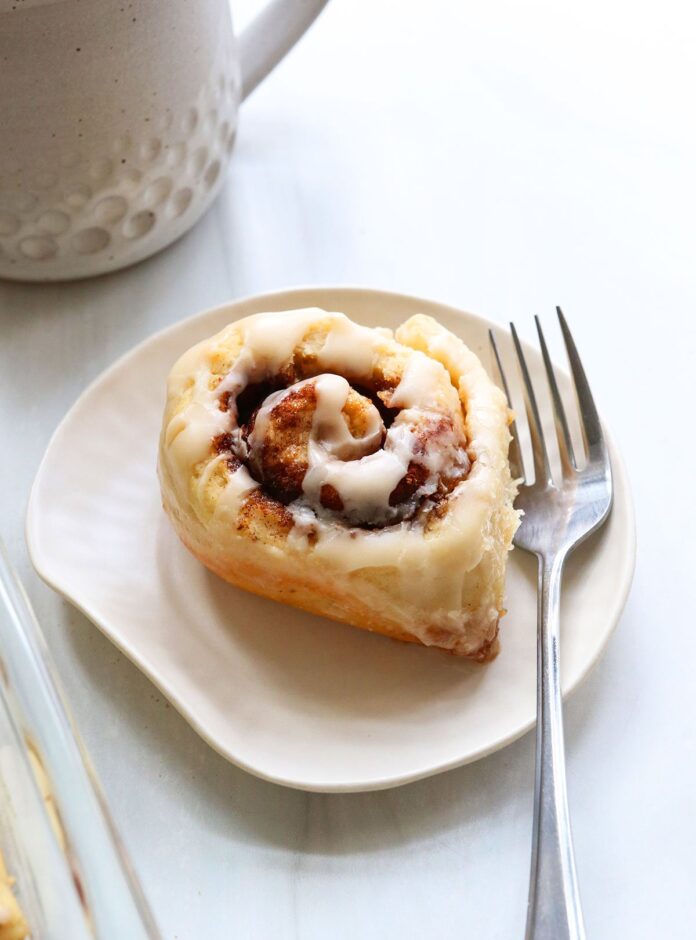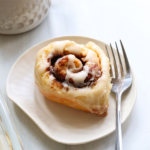We take cinnamon rolls in our house very seriously, especially around the holidays. They need to be tender, gooey in the center, and easy to slice with a fork. (No biscuit texture allowed!)
When I learned that one of our family members needed a gluten-free option, I thought it might be easy to tweak our go-to recipe by using a gluten-free flour blend, but as it turns out, it wasn’t that easy. Luckily, I’m quite determined when I put my mind to something.
Over thirty batches of cinnamon rolls later, I’m proud to say that I’ve figured out the best way to make gluten-free cinnamon rolls. It requires a secret ingredient— so plan ahead— but this simple addition makes the taste and texture remarkably authentic. My family can’t tell the difference between these and the recipe we used to make for holidays!
⭐⭐⭐⭐⭐ Featured Review
“Just made these on Christmas Eve, and they are WONDERFUL! Thank you Megan! I always trust your recipes and this one blows my mind. The texture, the flavor, the sweetness – all are perfect.”
-Lisabe
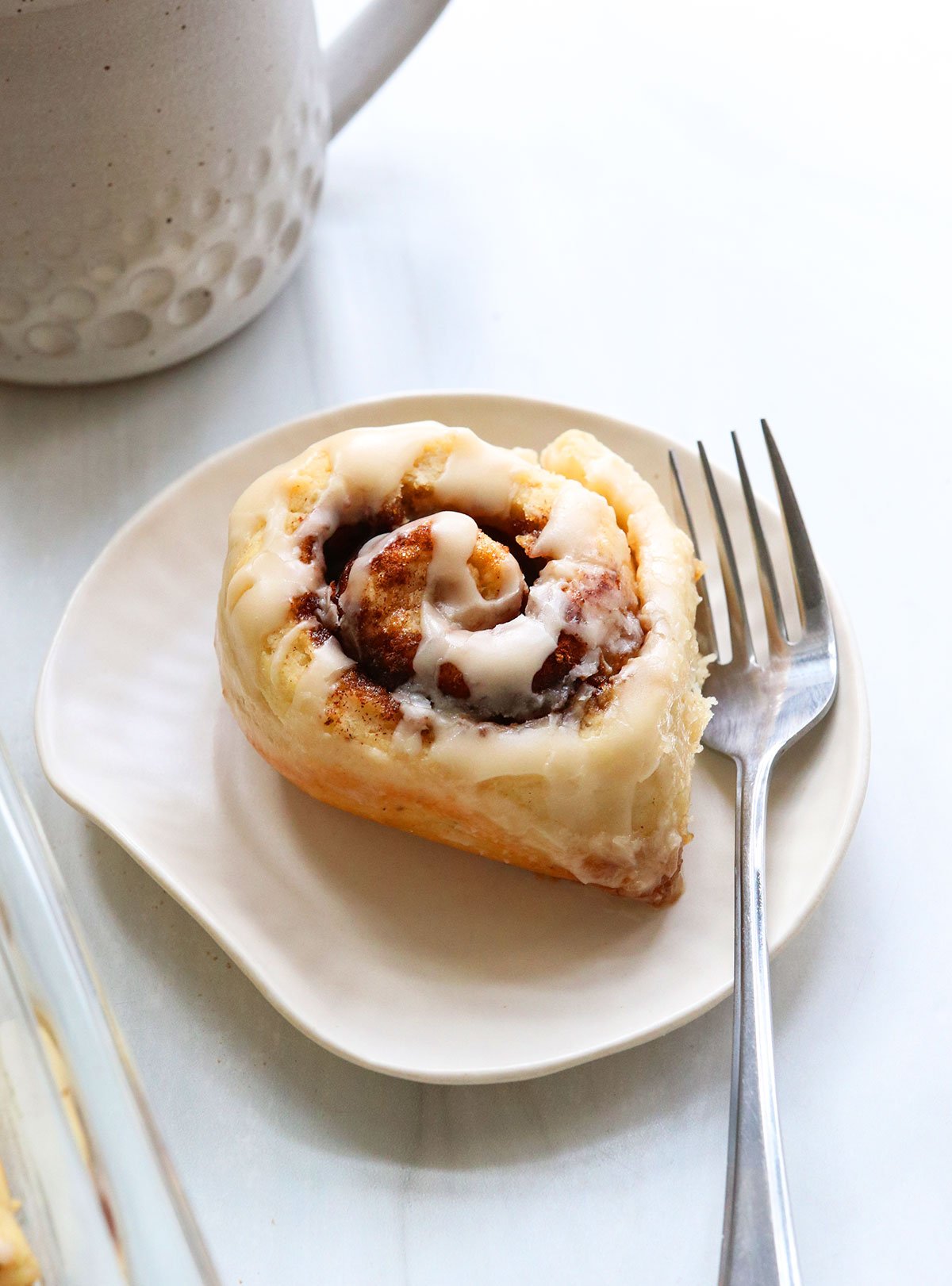

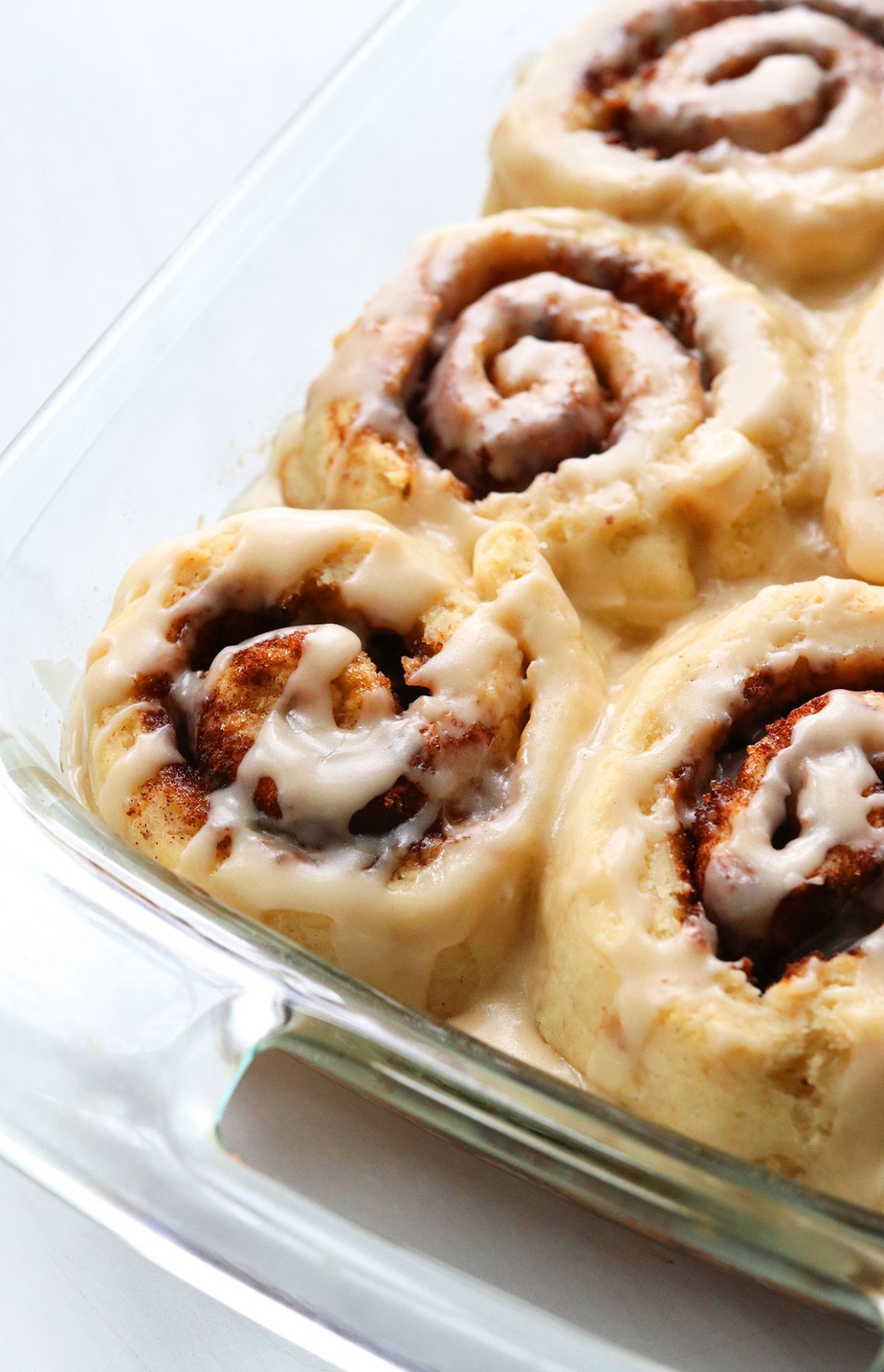

Ingredients You’ll Need for GF Cinnamon Rolls
- Gluten-Free Flour. I recommend using Bob’s Red Mill 1-to-1 Baking Flour (affiliate link) since that’s what I tested this recipe with.
- Active Dry Yeast. This helps the cinnamon rolls rise, but you can skip the “proofing” step at the beginning if you need to use instant yeast instead. In that case, just add the warm water and yeast directly to the dough.
- Psyllium Husk. This is the “secret ingredient” that makes gluten-free flour behave like it contains gluten. It’s magic, and should not be skipped. Find it in the supplement section of your grocery store. (It can also be stirred into water as a fiber supplement.)
- Egg. This helps bind the dough together so it will be easier to roll. Refer to the FAQ section below for egg-free tips.
- Butter. I use butter in this recipe for the best flavor and texture (it’s a holiday recipe, after all), but you can use coconut oil if you need a dairy-free option. See the tips in the recipe notes.
- Pantry Staples. Sugar, cinnamon, baking powder, and salt round out the rest of the dough ingredients. Don’t use baking soda instead of powder, or the flavor will be ruined.
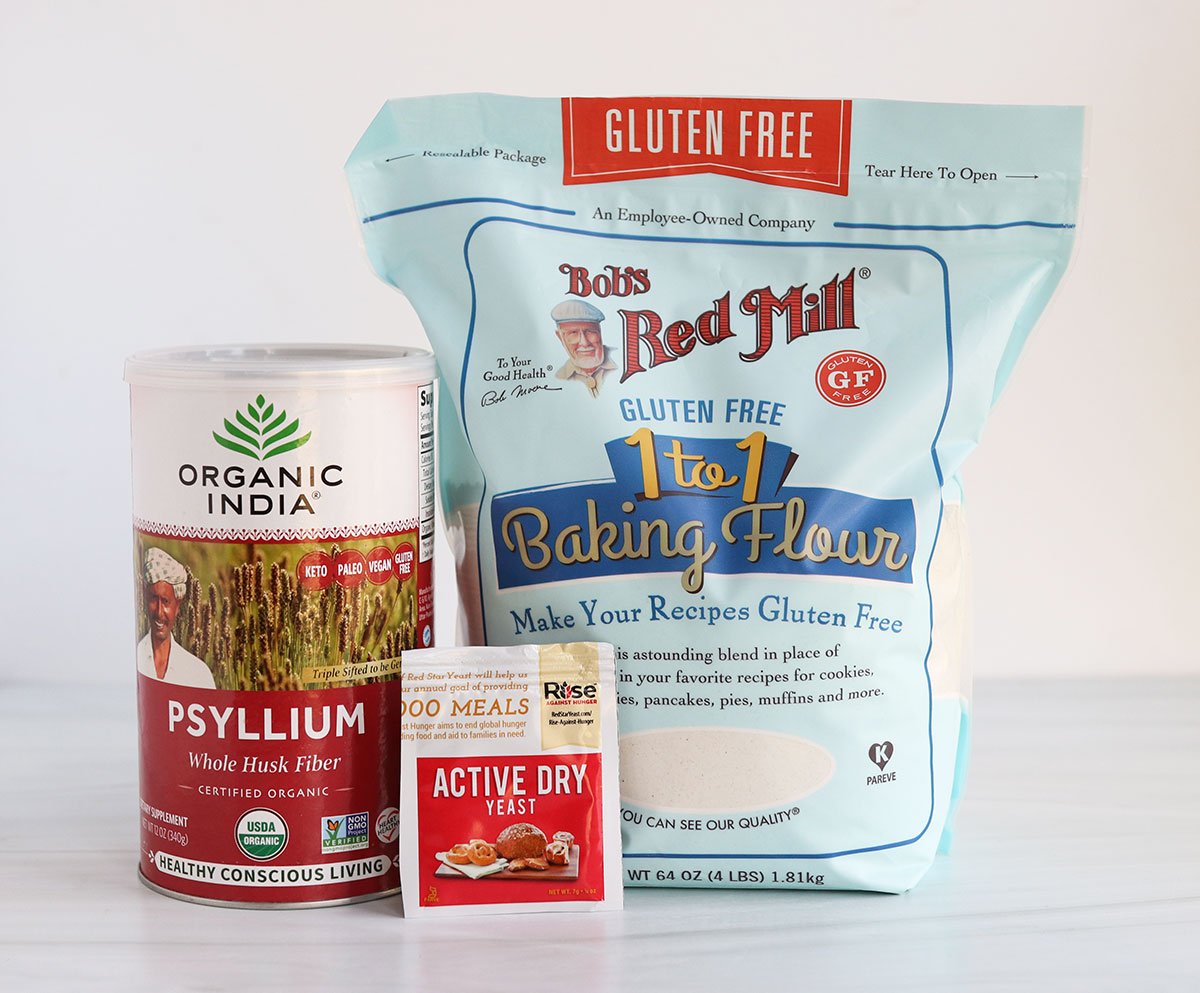

How to Make Gluten-Free Cinnamon Roll Dough
Step 1:
In a medium bowl, combine the very warm but not too hot water (between 105º and 115ºF is ideal), one teaspoon of sugar, and a packet of yeast.
Let the yeast mixture rest for 5 minutes. It should develop foam on top, which indicates that the yeast is good.
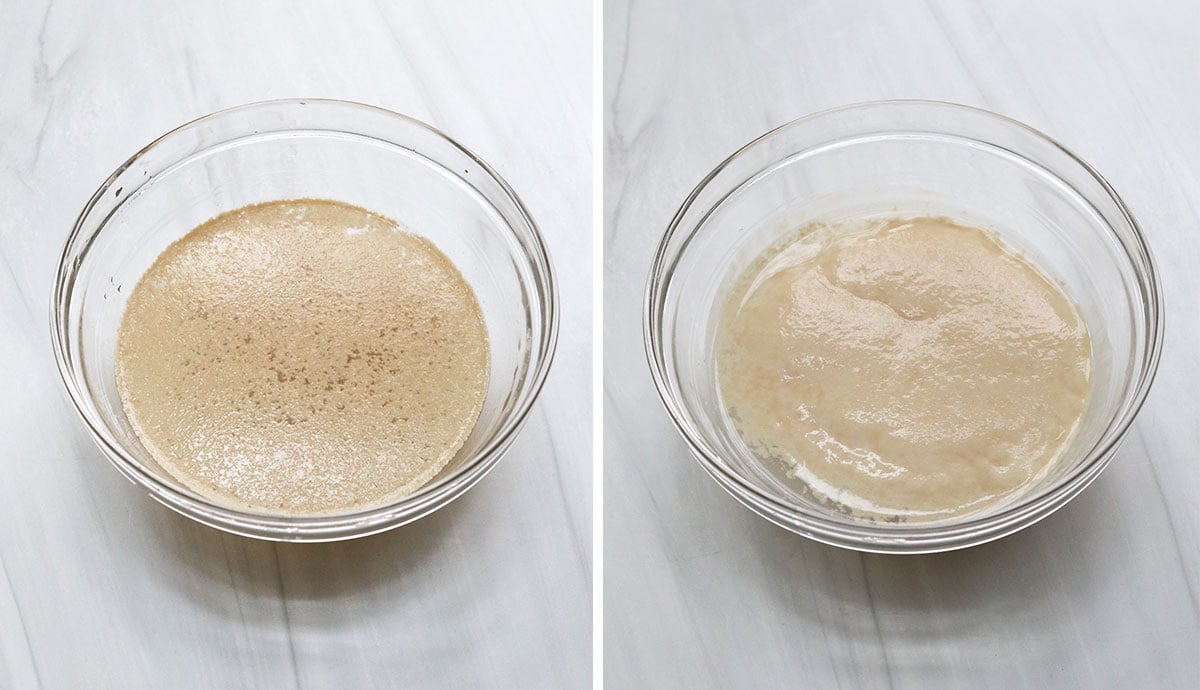

Step 2:
In a separate bowl, combine the psyllium husks and 3/4 cup of warm water. Stir the mixture until it starts to thicken. If you’ve ever made a flax egg before, it will look similar but thicker after resting.
Set the bowl aside until you’re ready to add it in.
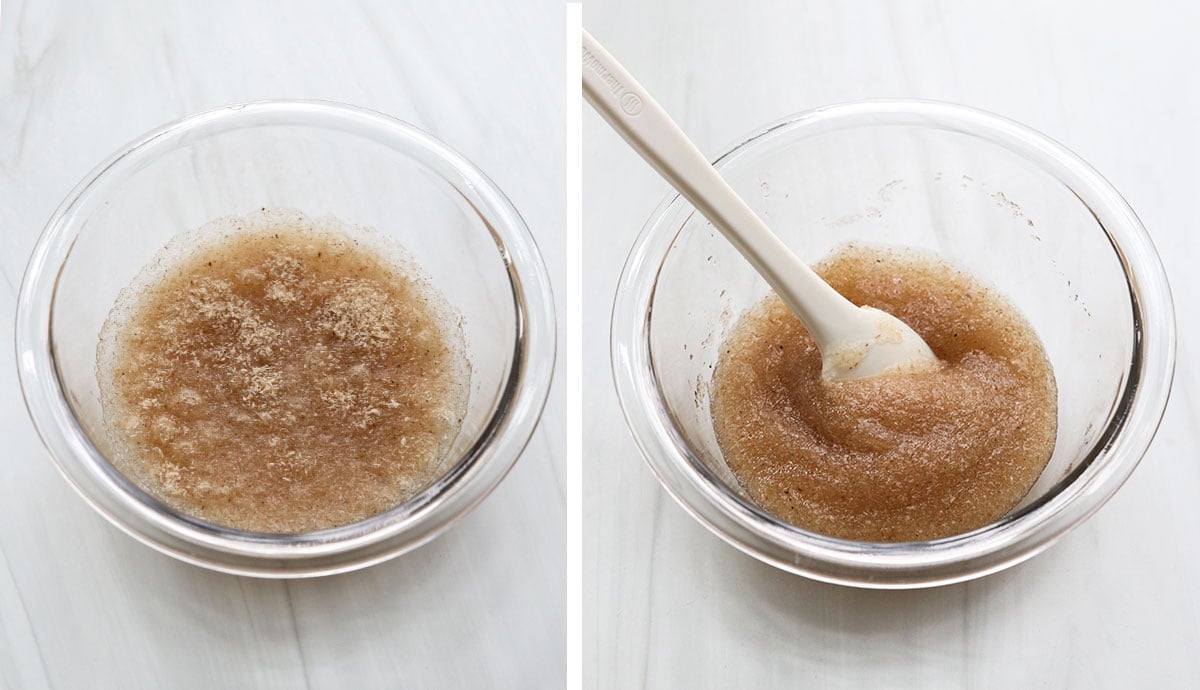

Step 3:
In a large mixing bowl, combine the gluten-free flour blend, sugar, baking powder, and salt. Whisk well to combine the dry ingredients.
Next, add the egg, melted butter, and the yeast mixture once it has developed the foam on top. Stir well, then add in the psyllium mixture. It will be thick, but keep stirring until the batter looks uniform.
Note: Gluten-free cinnamon roll dough will be slightly more moist and sticky than you might expect, but the flour will continue to absorb some of the moisture as it rests.
Transfer the bowl of dough to a warm spot to rise for 1 hour. (A “proof” setting in your oven is ideal, but you can also set the bowl on a low-heat heating pad and cover it with a towel or plastic wrap if your kitchen is cold.) The dough won’t double in size, but it should expand.
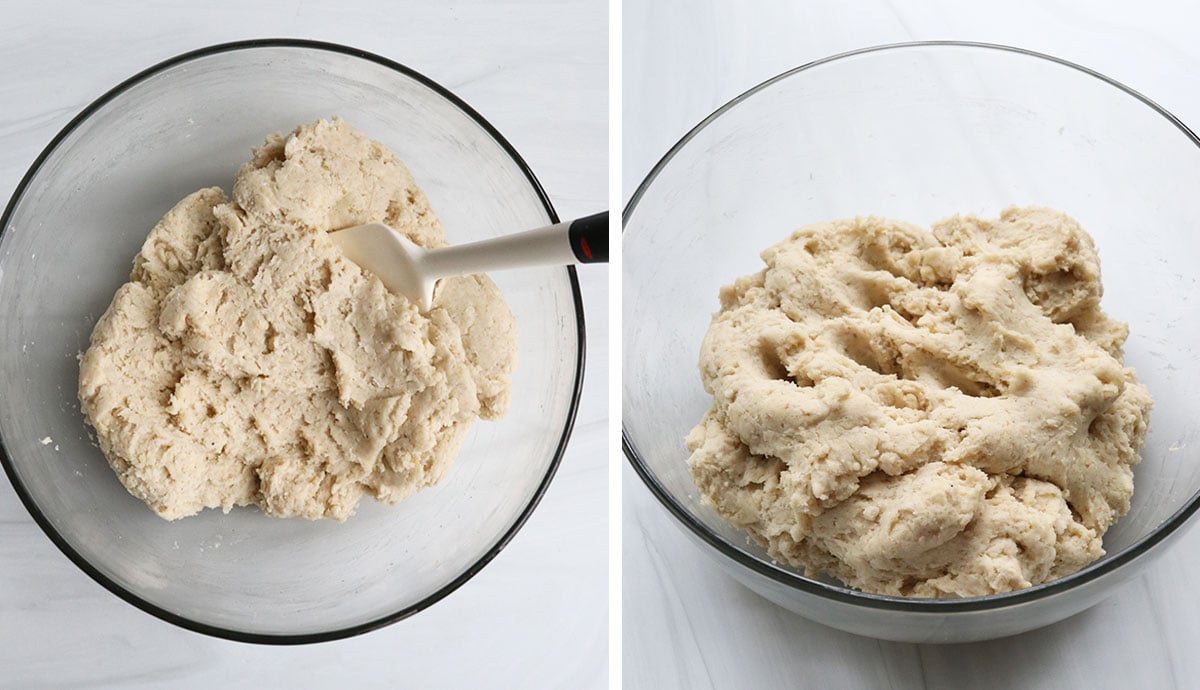

How to Roll Cinnamon Rolls
Step 1:
Once the dough has had a chance to rise, knead it directly in the bowl to ensure it is well-mixed. The underside of the dough will be more moist than the top, so it might stick to your fingers slightly. This is okay!
Transfer the kneaded dough to the center of a large piece of parchment paper on your counter.
Cover the dough with another large piece of parchment paper, then use a rolling pin to roll the dough into a large rectangle, about 11 by 16 inches in size and 1/8 inch thick. The extra layer of parchment on top will prevent you from needing to add more flour to the recipe.
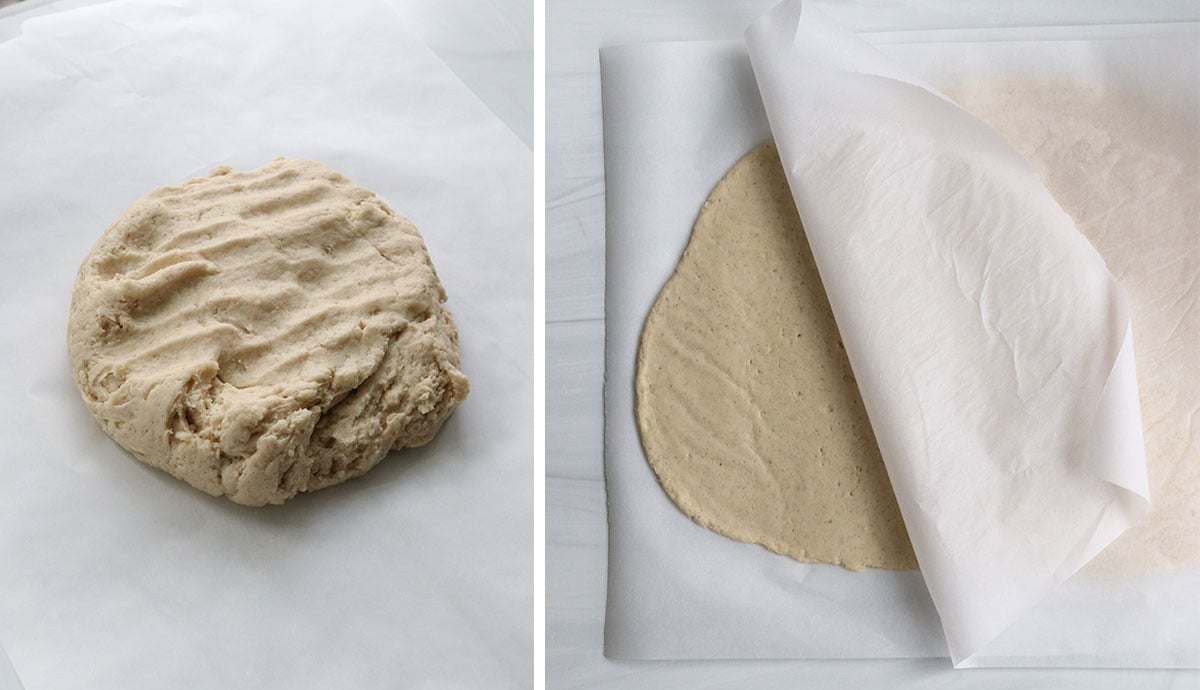

Step 2:
Remove the top piece of parchment paper, then pour the melted butter on top and spread it around the rectangle. Sprinkle on the brown sugar and a generous layer of cinnamon. Leave a 1/2-inch of dough at the top plain, so it will be easier to seal the roll later.
Starting at the bottom of the rectangle, lift the parchment paper with both hands and roll the dough upward. Gluten-free dough is relatively fragile, so using the parchment paper will keep it rolling smoothly. Continue rolling up the dough until you reach the other side at the top.
Use your fingers to pinch the roll closed, then slice it with a sharp knife (or unflavored dental floss). This recipe should yield roughly 10 rolls.
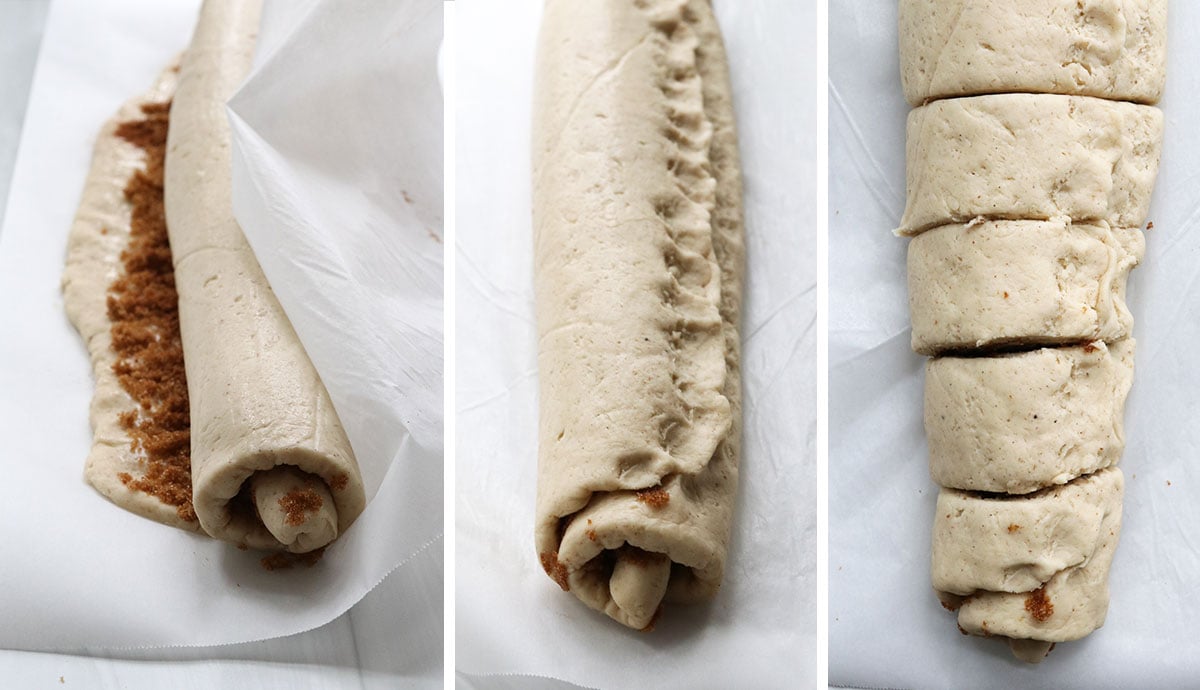

Step 3:
Grease the bottom of a 9-by-13-inch baking pan and arrange the rolls in the pan. You can also use two 8-inch cake pans instead.
Pro Tip: Instead of simply greasing the pan, pour three tablespoons of melted butter into the bottom of the baking dish, making sure to grease the sides of the pan, too. Sprinkle roughly 2 to 3 tablespoons of sugar over the butter, then arrange the sliced cinnamon rolls on top. As they bake, the butter and sugar will caramelize on the bottom of the cinnamon rolls, making them extra delicious. The bottom will be just as irresistible as the top!
Place the pan back in the same warm spot to allow the rolls to rise for a second time, about one more hour. They should grow in size and start to fill up the pan. When you have 20 minutes left on the second rise, preheat the oven to 350ºF.
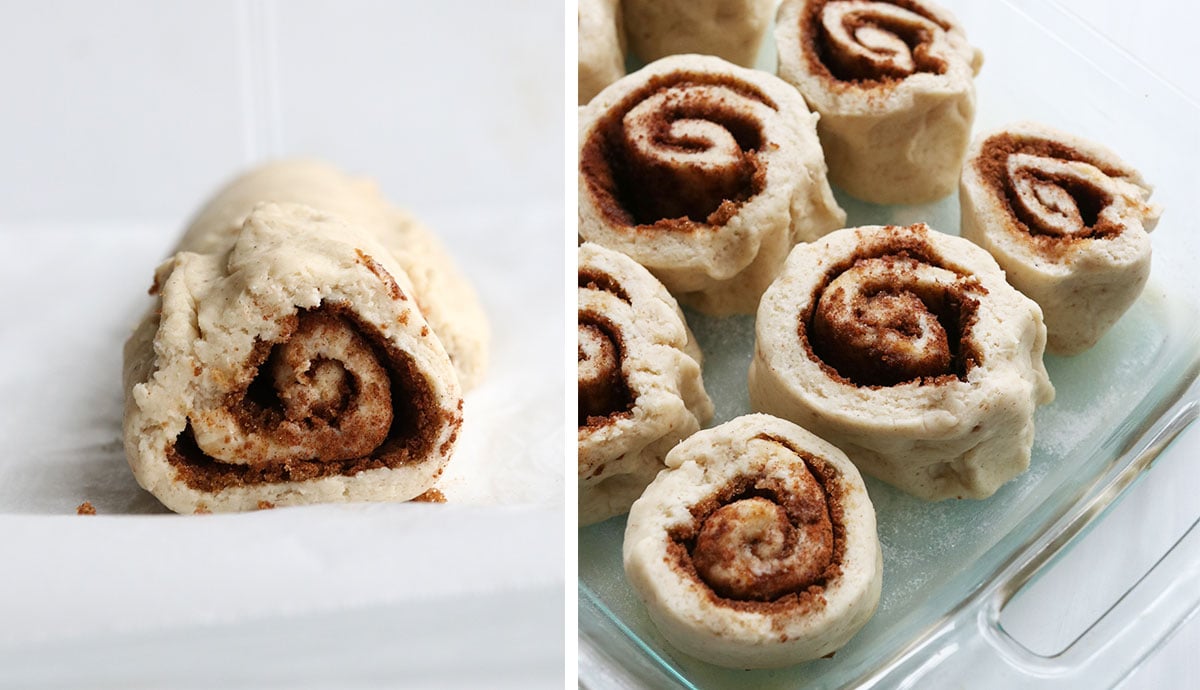

How to Bake GF Cinnamon Rolls
When the rolls have 20 minutes left of rising time, preheat the oven to 350ºF.
Then, bake them at 350ºF for 25 minutes, until the tops look dry. They won’t become quite as golden brown as regular gluten-containing cinnamon rolls, but they should grow in size and fill the pan as they bake.
Remove the pan from the oven and let the cinnamon buns cool for 10 minutes.
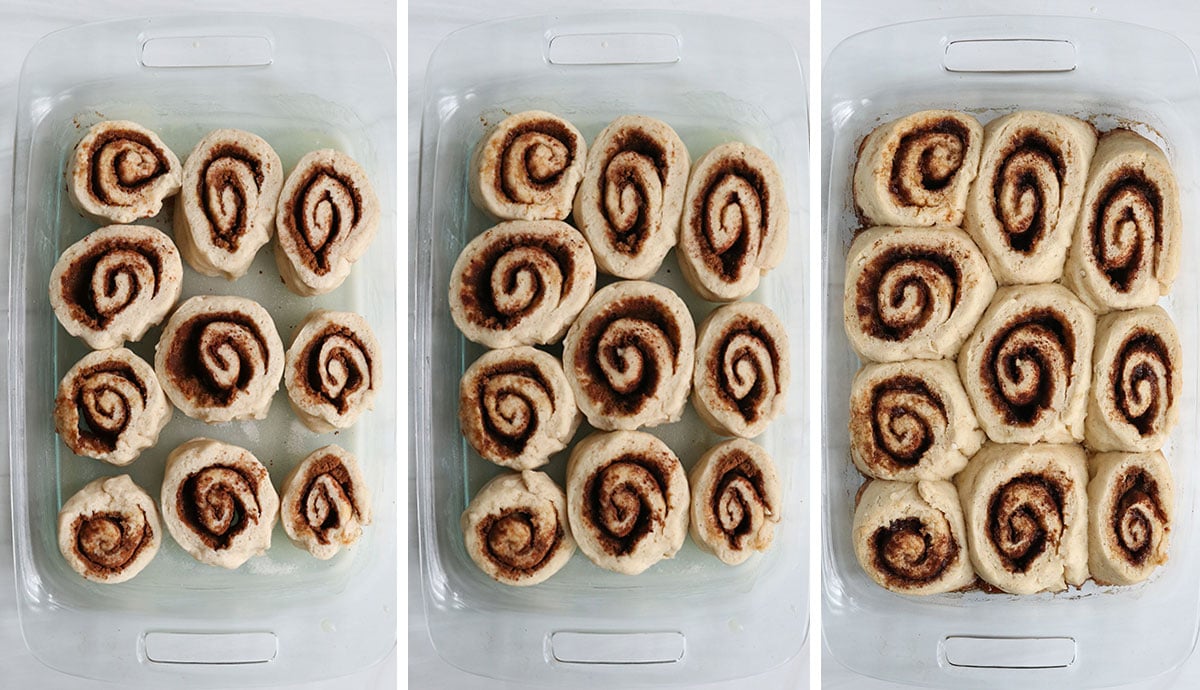

Cinnamon Roll Frosting
While the cinnamon rolls cool, stir together the melted butter, powdered sugar, vanilla extract, and water to make a melt-in-your-mouth glaze. Or, use your favorite cream cheese frosting, or try cashew frosting for a naturally sweetened option.
Serve the cinnamon rolls right away after frosting, or let them rest until you’re ready to serve. They are delicious at room temperature, too!
Be sure to transfer them to the fridge and cover them tightly if you don’t plan to serve them within 2 hours.
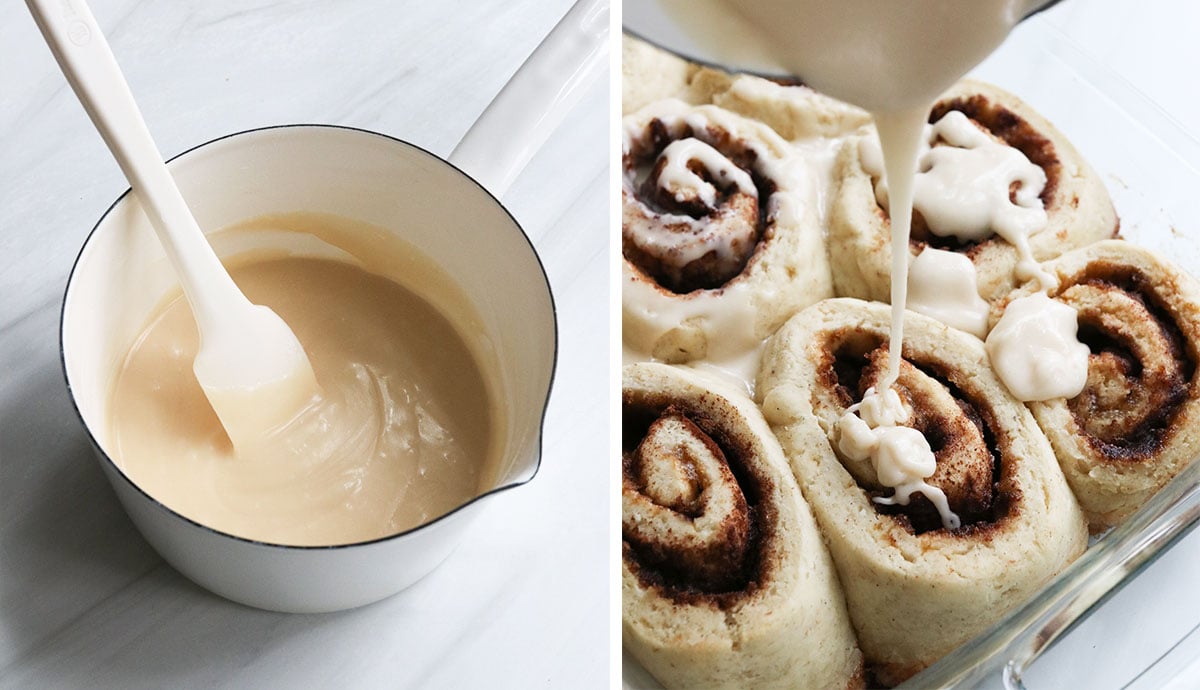

How to Store GF Cinnamon Rolls
Leftovers can be stored in an airtight container in the fridge for up to 5 days. Make sure they are tightly covered so they don’t dry out. To reheat, you can microwave a roll for about 20 seconds, or place it in the air fryer at 350ºF for 4 to 5 minutes.
Filling
- 2 tablespoons melted butter
- ½ cup brown sugar
- 2 ½ teaspoons ground cinnamon
Caramelized Bottom of the Pan (Optional)
- 3 tablespoons melted butter
- 3 tablespoons sugar
Frosting
- 2 tablespoons melted butter
- 1 ½ cups powdered sugar
- 1 teaspoon vanilla extract
- 2 tablespoons water
-
Add 1 cup of very warm water to a medium bowl, and sprinkle in the 1 teaspoon of sugar, and the packet of yeast. Set it aside to proof, about 5 minutes. A foam should develop on top, which will let you know that the yeast is good. (If no foam develops on top after 5 to 10 minutes, you might want to try a different batch.)
-
In another separate bowl, combine the 3 tablespoons of psyllium husk with an additional ¾ cup of very hot water. Stir well, and set it aside. (The husk will thicken up significantly, forming a thick gel.)
-
In a large mixing bowl, combine the gluten-free flour, sugar, baking powder, and salt. Whisk well to mix the dry ingredients, then add in the egg, melted butter, and the yeast mixture, after the foam has developed on top. Add in the psyllium husk gel, and mix well, until the dough looks thick and relatively uniform.
-
Place the bowl of dough in a warm place (like in an oven on a “proof” setting, or on a low-heat heating pad) to rise for 1 hour. The dough will not double in size, but it should expand.
-
When the dough is finished rising, knead it in the bowl for 2 minutes. The underside of the dough will feel slightly sticky, so don’t be surprised if it sticks to your fingers a bit. (Don’t add more flour, though. You should be able to wipe the dough off the tips of your fingers and drop it back into the bowl.)
-
Place a large piece of parchment paper on the counter, and set the dough in the center. Cover the dough with another large piece of parchment paper, so it won’t stick to your rolling pin, then roll it out into a large rectangle, about 11 by 16 inches in size. (Roughly ⅛-inch thick.)
-
Add the filling to the rectangle, leaving about a ½-inch at the top untouched, so it will be easy to seal the roll later. Spread on the melted butter first, then sprinkle the brown sugar and cinnamon evenly over that. Use the parchment paper under the dough to help roll it up into a long log, starting with the bottom (longest side) of the rectangle and moving your way up to the top. The parchment paper will prevent the dough from breaking as you roll. Once you reach the top, pinch the roll closed at the seam. Cut the log into 10 equal pieces.
-
Prepare a 9-inch by 13-inch baking dish by spraying it with oil. Optional: Create a caramelized bottom by spreading 3 tablespoons of melted butter into the bottom of the pan. Sprinkle 3 tablespoons of sugar over the butter, then arrange the cinnamon rolls on top of the sugar, in a single layer in the pan. The butter and sugar on the bottom will caramelize as the cinnamon rolls bake, creating a delicious bottom side to the rolls. Place the pan back in a warm spot to rise for 1 more hour. The cinnamon rolls should grow in size, but not necessarily double.
-
Preheat the oven to 350ºF for at least 20 minutes in advance, so the oven comes to the proper temperature. When the cinnamon rolls are done with the second rise, place them in the preheated oven to bake for 25 minutes. Gluten-free rolls don’t brown the same way gluten flour does, so they won’t be golden brown, but they should feel dry to the touch and spread to fill the pan. Remove them from the oven and let them cool for at least 10 minutes while you mix the frosting together.
-
To prepare the frosting, combine the melted butter, powdered sugar, vanilla, and water. Stir well, until the frosting looks smooth. You can add an additional teaspoon of water, if needed, to thin out the texture. Spread the frosting over the warm cinnamon rolls, then they are ready to serve. Leftovers can be stored in an airtight container in the fridge for up to 5 days.
• You can find whole psyllium husk in the supplement section at most grocery stores, or you can order it online or find it at a vitamin or health food store. Be sure to look for the word “whole” when purchasing this, as it also comes in a powdered form that is more concentrated. It should look similar to ground flax seed, only lighter in color.
• I used white and brown sugar in this recipe to make them more like the traditional version we make for Christmas morning. If you prefer to use natural sweeteners all year round, feel free to swap them for coconut sugar. (You can even make “powdered” coconut sugar by blitzing it in a high-speed blender!)
• For dairy-free cinnamon rolls: Swap the melted butter for melted coconut oil. I highly recommend using refined, or expeller pressed, coconut oil, so it won’t add a coconut flavor to your cinnamon buns.
• For vegan cinnamon rolls: Make the dairy-free swap above, and replace the egg with 1 more tablespoon of psyllium husk + 1/4 cup of warm water as an egg substitute. Look for granulated sugar that is labeled organic, to make sure it is vegan friendly.
• The caramelized base and frosting are inspired by Paula Deen. My family has made her original gluten-filled recipe for years! Also, a big shout out to The Loopy Whisk, who has an awesome post on using pysllium husk in gluten-free baking. I was about to give up on having delicious GF cinnamon rolls before I thought to add in psyllium husk!
Calories: 416kcal | Carbohydrates: 68g | Protein: 5g | Fat: 16g | Saturated Fat: 9g | Polyunsaturated Fat: 1g | Monounsaturated Fat: 4g | Trans Fat: 1g | Cholesterol: 55mg | Sodium: 295mg | Potassium: 111mg | Fiber: 7g | Sugar: 35g | Vitamin A: 452IU | Vitamin C: 0.02mg | Calcium: 93mg | Iron: 2mg
More Gluten-Free Recipes to Try
If you try this gluten-free cinnamon roll recipe, please leave a comment and star rating below, letting me know how you like them.


